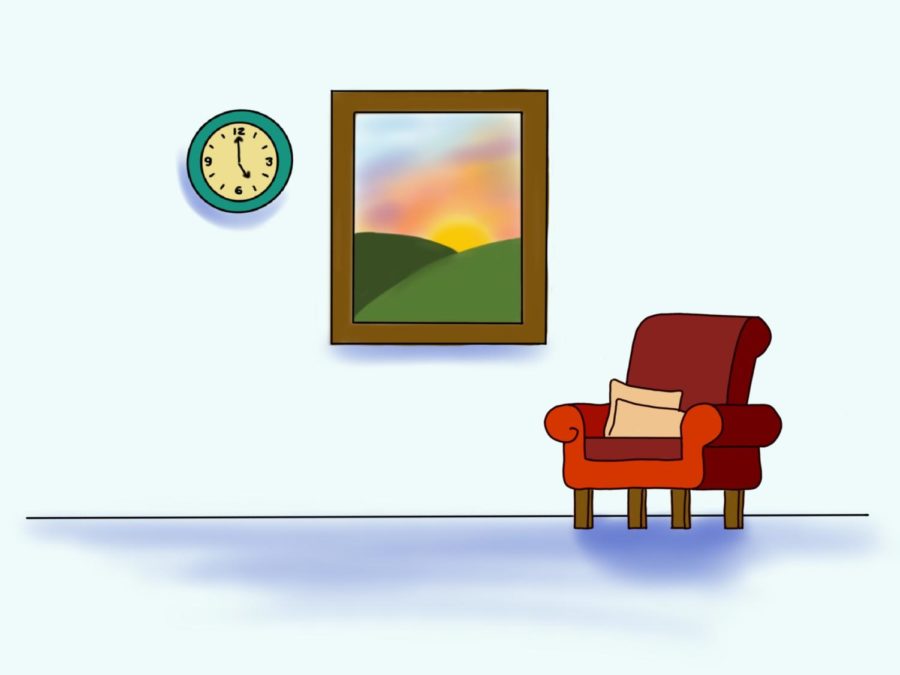Daylight Savings Doesn’t Save Us Anything
On Sunday, Nov. 7, the time changed so the clocks fell back an hour. Staff illustration: Dorinda Xiao.
November 18, 2021
When you get out of school and the sun is already setting, it’s easy to feel a sense of exhaustion and lack of motivation. Students already feel tired from a long day at school, and some still have practice and then several hours of homework to do. But there’s only one more hour of light to get these things done before the world goes to night.
On Sunday, Nov. 7, the clocks fell back an hour to Standard Time. This means brighter mornings and darker evenings. In the spring, we will spring forward to Daylight Time, which brings an extra hour of sunlight into the evening. The shift of clocks raises the age-old debate: Standard or Daylight Time? The answer is not as black and white as it may seem.
My immediate reaction is that Daylight Time is more convenient; having an extra hour of light in the afternoon allows me to be more productive and get more accomplished after school. I know I like it to be bright when I am running at cross country practice, although it is hard to get out of bed in the morning when it is still pitch black outside. Regardless, I would still prefer to have an extra hour of daylight in the evenings than in the morning because I need more light to be productive while doing extracurriculars and schoolwork.
According to Professor Steve Calandrillo at the University of Washington, the extra hour of sunlight mitigates risks such as fatal car accidents and higher levels of crime that occur due to darkness earlier in the evening. Moreover, businesses benefit from people leaving their homes and spending money when it is lighter out for longer. The shift from Daylight Time to Standard Time when an hour of light is lost is linked to an 11% increase in depressive episodes ten weeks after the switch, according to a 2017 Epidemiology study. Proponents of Daylight Time ask people to consider the following: are you more likely to be outside in the world at 7:30 a.m. or 5:30 p.m.? The answer is typically the latter, boosting the case for daylight savings.
Despite these benefits, Daylight Time misaligns social clocks with the solar clock. According to The New York Times, social clocks are basic timetables for daily activities, such as waking up for school or work and going to bed. The solar clock is the actual number of hours of light and dark due to the earth’s rotation around the sun. Daylight Time maximizes the hours of daylight which works well in the summer but in the winter results in dark mornings due to the Earth’s rotation on its axis. When the social and solar clocks become misaligned, the hours we are awake and asleep do not correlate with the hours of daylight and darkness. The phenomenon is known as “social jet lag” and has serious health effects including increased metabolic disorders, cardiovascular problems, mood disorders and even reduced life expectancy, according to Society for Research on Biological Rhythms scientists Erin Flynn Evans and Cassie Hilditch.
The alternative to Daylight Time is Standard Time which scientists from the American Academy of Sleep Medicine say is better overall for people’s health because it would eliminate the loss of an hour of sleep during the transition to Daylight Time. The lost hour of sleep has been linked to higher heart attack risk, more workplace injuries and more car-accident deaths, according to The New York Times.
The issue at this point comes down to the time change itself, not Daylight versus Standard Time. The solution is to set one as a constant so no time change would be necessary which would eliminate any health risks caused by the switch. With this in mind, Daylight Time is the best option because it allows for increased productivity, business success and lower rates of depressive episodes.
Today, many people find the clock change is cumbersome and confusing, with only 70 countries in the world following it. Even within the United States, Arizona and Hawaii don’t make the change. Senators such as Marco Rubio and Ed Markey are pushing to make Daylight Time permanent, so Rubio introduced the Sunshine Protection Act in 2018.




